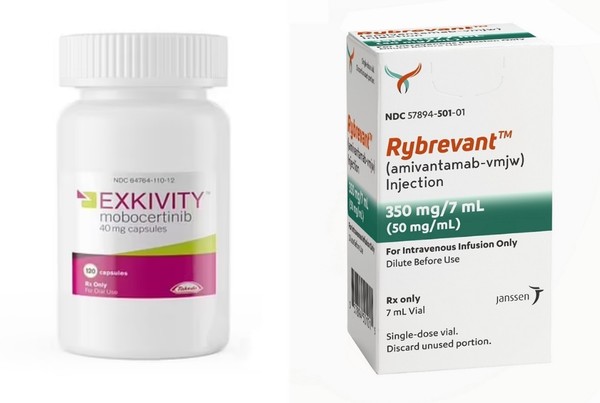Takeda’s oral drug Exkivity (mobocertinib) won the regulatory nod to treat non-small cell lung cancer (NSCLC) with epidermal growth factor receptor (EGFR) exon 20 insertion (Ex20ins) mutation in Korea.
The approval will prompt its competition against Janssen’s Rybrevant (amivantamab), an injection that recently obtained marketing approval to treat the same disease, observers said.

On Tuesday, the Ministry of Food and Drug Safety authorized Exkivity to treat adults with locally advanced and metastatic NSCLC with EGFR Ex20ins mutation who have been treated with platinum-based chemotherapy.
NSCLC is the most common type of lung cancer, but EGFR Ex20ins mutation accounts for only 1-2 percent of NSCLC.
While survival rates of patients with common NSCLC such as EGFR exon 19 deletion and exon 21 L858R mutation have significantly improved with third-generation targeted therapy, those with EGFR Ex20ins mutation have been treated with platinum-based chemotherapy as the standard care.
The five-year survival rate of NSCLC patients with EGFR Ex20ins mutation remains below 9 percent, which is only half that of other EGFR mutated patients.
Existing EGFR TKIs showed less than a 10 percent response rate in EGFR Ex20ins mutation, so the medical and clinical needs are largely unmet in this treatment area.
However, EGFR Ex20ins mutation targeted therapies for the second-line or higher stage treatment recently emerged one after another. They come in various forms so that patients can get customized therapy.
Takeda’s Exkivity is one of them. It is the first-in-class oral TKI selectively targeting EGFR Ex20ins mutation in NSCLC.
The approval for Exkivity was based on the pooled subgroup results from multinational, open-label, and multi-cohort clinical trials (AP32788-15-101, NCT02716116).
In the efficacy analysis group, 114 patients had locally advanced or metastatic NSCLC whose EGFR Ex20ins mutation was confirmed during or after platinum-based chemotherapy. The administration of Exkivity 160mg once daily showed a 28 percent objective response rate (ORR), and the median duration of response (DoR) was 17.5 months.
The most common adverse events of Exkivity were gastrointestinal toxicity such as diarrhea. Ninety percent of Exkivity-treated patients reported diarrhea, and 20 percent of them were grade 3.
Another option for EGFR Ex20ins mutation is Janssen’s Rybrevant, which won the permit for the same indication as Exkivity’s in February.
Rybrevant is a bispecific antibody targeting EGFR and MET simultaneously. It is an intravenous injection that can be administered every two weeks after a month of titration.
Rybrevant obtained the nod based on the results of a phase 1 CHRYSALIS study without a control arm. In the study, the ORR of Rybrevant-treated 81 patients was 40 percent.
The most common adverse reaction of Rybrevant injection was the infusion-related reaction (IRR), with up to 80 percent of the patients reporting it.
However, Janssen said that IRR mainly occurred in the initial administration and could be reduced by divided administration. As long as a patient passed the initial IRR well, it did not reoccur.
Another major side effect of Rybrevant was skin toxicity.
Exkivity and Rybrevant are expected to offer more options to NSCLC patients with EGFR Ex20ins mutation with different usage and safety profiles, industry officials said.
No study compared the two treatments directly, but Rybrevant is slightly ahead of Exkivity regarding the response rate and adverse reactions.
Still, Exkivity’s advantage as an oral drug is expected to satisfy patients who are reluctant to visit hospitals frequently and get injections.
Attention is on how the two drugs will compete in the Korean market.

